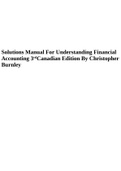Tentamen (uitwerkingen)
Solutions Manual For Understanding Financial Accounting 3rdCanadian Edition By Christopher Burnley.
- Vak
- Instelling
Solutions Manual For Understanding Financial Accounting 3rdCanadian Edition By Christopher Burnley. Contents 1 Overview of Corporate Financial Reporting 1-1 Dollar Store Business Is No Small Change 1-1 Introduction to Financial Accounting 1-3 What Is Financial Accounting? 1-3 Users and Use...
[Meer zien]



